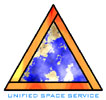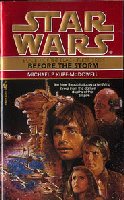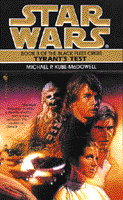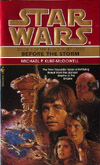
Star Wars: The Black Fleet
Crisis
by Michael P.
Kube-McDowell
Last Revised: Tuesday, July 07, 2009
 |
Star Wars: The Black Fleet
Crisis
|
 |
Book 1: BEFORE THE STORM Publication Date:
April, 1996
|
 |
Book 2: SHIELD OF LIES Publication date:
September, 1996
|
 |
Book 3: TYRANT'S TEST Publication date:
January, 1997
|
More information:


 Last Revised:
July 07, 2009
Last Revised:
July 07, 2009Warning! This FAQ contains many spoilers! If you haven't read the trilogy yet, beware!
It's about 300,000 words...
Sorry, old writer's joke.
But there's a germ of truth in it--my outline for the trilogy was 20 manuscript pages, and I wasn't happy with how well that captured the "what's it about" for these books. I almost always hate any one-or two-paragraph summary of my novels, whether written by me, a publisher, or a reviewer. Those capsules so rarely capture what the book feels like to me--because a novel is so much more than a summary of its plot. Most all of the interesting dimensions are necessarily left out.
With those caveats...
THE BLACK FLEET CRISIS begins sixteen years after SW, in a time of peace for the New Republic--and with peace comes the first real chance for the weary warriors of the Rebellion, now in mid-life, to turn their attention to personal concerns which have taken a back seat to the duties and obligations of leadership. Han is placed on detached duty as he commits himself to parenting and protecting the children. Chewbacca goes home to Kashyyyk for his son's coming-of-age ceremonies and an extended visit as the returning hero. Luke builds a hermitage on Coruscant and disappears into it in pursuit of the deeper enlightenments of the Jedi path--until a woman approaches him with the tantalizing promise of leading him to his mother's people. Lando, bored with both business and politics, comes to a New Republic covert ops chief in search of something interesting to occupy him--and is handed the puzzle of the Teljkon vagabond, a mysterious "Flying Dutchman" starship which lurks in deep space and flees from all contact.
The only person who can't put down her burdens is Leia, who--by virtue of her fame, the expectations of others, and her own sense of duty and obligation--has become a prisoner of the Presidency. But she's tired, stressed to her limits, emotionally fragile--two steps away from a profound personal crisis of confidence. And Nil Spaar, the canny, ruthlessly machiavellian Viceroy of the Yevethan Protectorate, sees that as an opportunity he can exploit...an opportunity to shatter the New Republic from within.
It's true--at least in some respects, we haven't seen Leia like this before. But that's as it should be, because we've never seen her in these circumstances before.
Among real people, "character" isn't a single, unchanging quality. Where sentient beings are concerned, time and experience and the responsibilities we assume along the way bring different aspects of our nature to the fore. One's behavior, emotional state, and perspectives on the world are different at age 45 than they were at 30, and different at 30 than they were at 15. What's more, even considered at a single moment in time, people are complex, contradictory and multi-dimensional--we are vast, we contain multitudes. And everyone has days (weeks, months, even years) when they're struggling to live up to their own image of who they are.
Even if everything was "normal"--no other issues or unprecedented circumstances--I feel very strongly that if I'd shown Leia at 34 to be unchanged from the way we saw her in STAR WARS, it would have been false and dishonest.
But, of course, everything isn't normal. In the simplest possible terms, Leia's having a crisis of confidence--suffering the effects of too many years with too much responsibility, exacerbated by Nil Spaar's skillful manipulation of her. She wants to be somewhere else, but doesn't know how to let go. She feels the weight she's carrying, and doesn't know how to stop it from taking its toll. In the end, that's all it comes down to--Leia's a complex person, not a single-dimension superheroine.
(People who are always strong, whose only challenges and problems come from the outside, I find not only uninteresting, but also unbelievable. I don't know anyone like that--and I doubt very much whether such people exist. And even if they do, I probably wouldn't be interested in writing about them. By contrast, when I see someone who's usually strong and self-composed struggling, I become very interested in what happened to place them in that state, and in whether--and how--they'll recover and rise above it.)
Here's some background on the K-wing assault bomber:
Prior to the introduction of the "New Class" designs, the Alliance (later New Republic) fleet consisted of many different types of ships purchased from, donated by or on loan from various Alliance/Republic members (or, in some cases, captured from the Imperial Navy). The variety of vessels--some types represented by only a single example--created tremendous logistical problems for Fleet maintenance and supply. The variation also created difficulties in regard to training, rotation, and promotion of Fleet personnel. Consequently, one of the primary considerations when the New Republic began design and construction of its own vessels was to vastly increase the degree of standardization.
The first of the New Class types was the Sacheen-class light escort. Later, the Hajen-class fleet tender was built as a variation on the basic Sacheen keel/hull/drive/systems package. This practice of building multiple configurations from a single base design was so successful that it was adopted for all subsequent New Class building programs.
Although several types entered service somewhat earlier, the Fifth Fleet is the first New Republic battle group comprised entirely of New Class vessels.
A few earlier designs remain in limited production, most notably the Corona-class frigate (examples: Boldheart, Endor, Shooting Star), Belarus-class medium cruiser (Glorious), and Republic-class star destroyer. Also, various small specialized vessels (such as prowlers and ferrets) are not covered by the New Class modernization plan.
Each New Class design is named for the first-of-type. Design "twins" are listed together.
| TYPE | ROLE | KEEL | EXAMPLES |
| Agave-class | Picket | 190m | Kauri, Pran, Nagwa |
| Warrior-class | Gunship | 190m | Marauder |
| Sacheen-class | Light escort | 375m | Trenchant, Kettemoor, Stendaff |
| Hajen-class | Fleet tender | 375m | Ahazi |
| Majestic-class | Heavy Cruiser | 700m | Resolve, Gallant, Illustrious, Indomitable, Liberty, Phalanx, Stalwart, Vigilant |
| Defender-class | Assault carrier | 700m | Repulse, Shield |
| Nebula-class | Star destroyer | 1040m | Brilliant |
| Endurance-class | Fleet carrier | 1040m | Endurance, Intrepid, Venture |
It's often hard to say exactly what the truth is where history's concerned. It tends to be written by the winners, to begin with--which introduces a nontrivial degree of bias. Beyond that, significant events often leave little documentation and few witnesses--leaving both events and motives open to interpretation, and historical persons permanently open to reexamination in the face of new evidence.
The short answer: the credited author.
With the sponsorship of former Bantam Spectra editor Tom Dupree, I "auditioned" for the opportunity to write a Star Wars trilogy on the strength of my novels Emprise and The Quiet Pools. After I was approved by Lucasfilm, both Bantam and Lucasfilm sent me cartons of background and reference material, including an extensive timeline distilling the events of the other licensed fiction (novels and comics). I studied the timeline for an unexplored window of time and began generating ideas about the storytelling possibilities which existed in that point in time. Those ideas became a three page-sketch, which I discussed with Tom. With Tom's endorsement of the "high concept," I went back and turned the sketch into the detailed 20-page formal submission outline. Bantam reviewed and approved the outline, and so did Lucasfilm in its turn. Finally, I wrote a second, shorter version of the outline (incorporating two modest changes requested or suggested by Lucasfilm) for George Lucas's personal review and approval. When that approval came, it was time to start writing.
Left to their own devices, most writers try to write the kind of stories they like to read, and explore the kinds of conflicts and questions they find interesting. That's where The Black Fleet Crisis really came from.
Twelve cents per copy on the U.S. editions of the trilogy--two percent. (The rest goes to the store, the wholesaler/distributor, Bantam, and Lucasfilm--in what proportions, I can't say.)
That's only 1/4 to 1/5 as much per copy as a pro writer ordinarily receives for a "home-grown" novel. We also get no share of the income from book clubs, foreign editions, or any other spin-offs and tie-ins. Balancing that--we hope--is the enormous fan base and the power of those magic words "Star Wars" to put books on the best-seller lists. All in all, it's a good gig, but don't expect to see your favorite SW author driving a late-model Porsche and sending his kids to boarding school--it's not that good a gig.
There was no thought to exclude anyone, and I'm always delighted when I receive a fan letter from a teen-aged reader (and even the occasional preteen). But the Bantam Spectra novels are considered the adult line, and I primarily had in mind readers who were 18 or so when the Star Wars films first came out, and who're now the age that the main characters are in the Black Fleet trilogy -- that is, readers in their 30s and 40s (like me). It seemed to me that there was plenty of SW material out there for younger folks, and that the action-oriented high-testosterone types of all ages could readily get their fill of that through the excellent LucasArts computer/video games. So I tried to write something that was a little more reflective and multi-layered, something informed by the experience of time--that life changes us, and the world changes around us.
You can't please everyone--tastes and expectations vary across too wide a spectrum. I tried to write about real people, not movie heroes, grappling with real issues, not technobabble and one-dimensional evil adversaries. I tried to respect the many-dimensioned wholeness of Luke, Leia, Chewbacca, and the others, and look in on them as they were facing problems that mattered in a world where failures and mistakes have consequences. That was my way of honoring the phenomenon that is Star Wars--by taking it as seriously as I did any other book I've written.
But after that, you have to be philosophical. Every reader has a different experience with, through and of a given book. And I'm very conscious of the fact that there are many different kinds of SW fans, and what pleases one group can leave another wanting. IMO, there's no way that any single book by any given writer (insert the name of your personal favorite here) could satisfy all of them.
Just to name two of the big lines of demarcation: some fans want the familiar characters to be just like they were in the movie trilogy, while others are more willing to let them grow and change. Some fans want a fast-paced action-filled novel, a very cinematic movie-in-words, while others want the greater depth of character and complexity of conflict that the novel form affords. I was writing primarily for the second group in both instances, hoping I could do it well enough to please some portion of the other groups but knowing that some readers would say "Not enough action!" and others would say "_____ is behaving out of character."
Yes. Several.
The eagle-eyed reader can look for a wink in the direction of Arthur C. Clarke, my daughter's name and birthdate, a nod to my Bantam editor, a ship named for the city the first two books were written in, and a character named after my youngest child (born while I was writing Tyrant's Test), among others.
In his younger days, Han wouldn't have dreamed of letting anyone else touch the Falcon. Like Luke, he has too much of the Saturday-afternoon driveway-mechanic in him. But the simple fact of the matter is that he has too many other responsibilities. He's the father of three fairly demanding kids, and the spouse of the single most important government official in the Galaxy. To borrow a phrase from a contemporary philosopher, the days are just packed.
And don't overlook the fact that one of the reasons Chewie and Han did so much by themselves, and were so 'creative' in their modifications, was that (a) they were always short of credits, and (b) they were usually working on the other side of the law. They had more time than money, and speed was more important than safety. Now things are exactly reversed--Han has more money than time, and you look at the 'family car' a lot differently than you look at a Friday-night-cruising hot rod.
Besides, Leia got tired of being stranded when something broke down, and insisted.
The same way it acquired mountains--a novelist took us somewhere we hadn't been before.
The geography of the whole of Coruscant has never been definitively laid out--just a few word sketches here and there, and the illos in the comics.
I would (and did, to Lucasfilm) argue that a city covering all of a planet's surface area is as unlikely to be ecologically viable as a planet with no large bodies of water. You've got to have a water cycle, you've got to have a carbon/oxygen cycle, you've got to have seas to moderate the extremes of temperature. Coruscant is supposed to be (have been) a wonderful place to live--it's not Mars or Ganymede covered with city, but something much more earthlike.
Economics also argue against the "Trantor"-type planetary city. The sheer volume of food and other consumables, raw materials, and manufactured goods required by an enormous urban population would turn the skies black with space freighters.
So consider the image of Coruscant as a planet-sized city a bit of Imperial propaganda. Instead, picture a planet with two continents, a major and a minor; the major continent is dominated by an admittedly grand and impressive Imperial City, but it also has the Manari Mountains, a western coastline that's something like Miami Beach in its prime, and frigid northern latitudes which are largely uninhabited. The minor continent is much more sparsely populated--the largest population centers having perhaps no more than a million inhabitants.
Just as it's written.
The standard phonetic system used in Basic renders it jeh-TEH-peh-tahn -- four syllables, rhythmic and percussive, with only a slight emphasis on the second syllable.
Don't spare the syllables. EYE-duh-dar niy-la-KER-ka
Both, and neither. (What, you don't like paradoxes?)
The Force, like all ineffable cosmic mysteries, has more than one face, and no sect can claim either ownership of it or the absolute right to define its nature. The Jedi path is an intensely masculine one--what is to say that there aren' t alternatives founded on different premises?
The key passage here is in Chapter 11 of Tyrant's Test. Luke is speaking: "The Force is a river from which many can drink, and the training of the Jedi is not the only cup which can catch it. If we didn't know that before we met the witches of Dathomir, we surely know it now."
![]() Return to Novel List
Return to Novel List